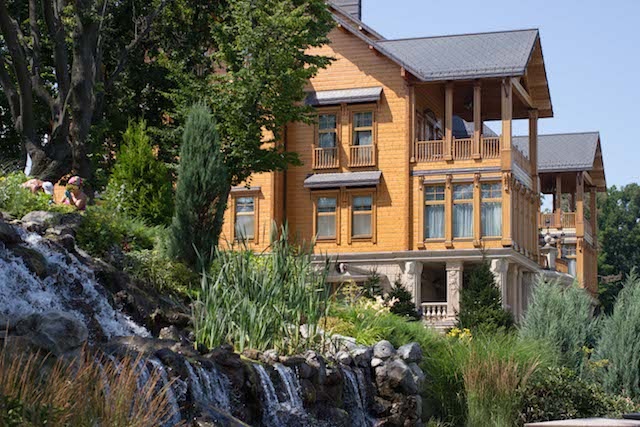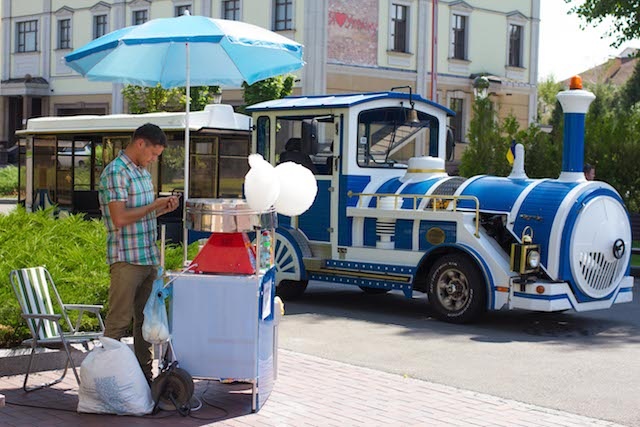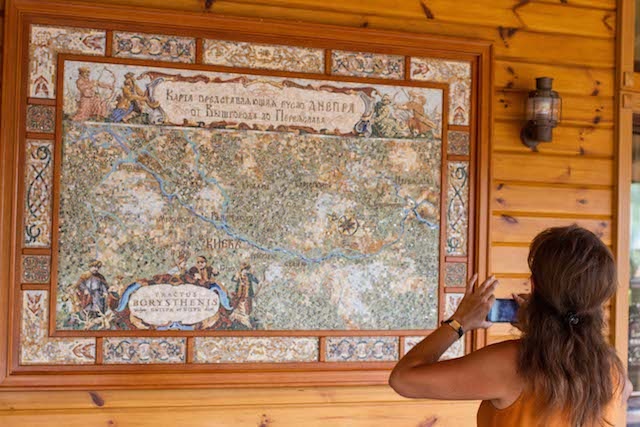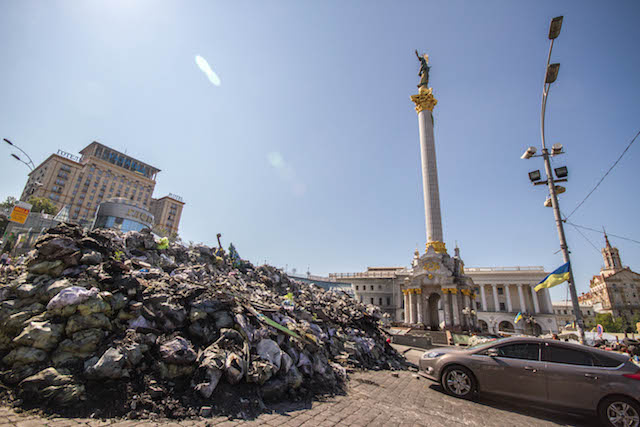Euromaidan, you may recall, is the name for the loosely organized political movement in Ukraine that began almost a year ago in Kiev’s Independence Square. Their demand was closer European integration, meaning greater distance from Putin, which in turn meant toppling the administration of President Viktor Yanukovych. The protests gave way to violence, and ultimately resulted in the 2014 Ukrainian Revolution.
As violence shifted away from Kiev to Eastern Ukraine, the world’s media followed. Shellings and shot-down airplanes were easier to sell on the front page than the lingering protesters in Kiev. A Willy Wonka–esque president was elected on pro-European promises, but the Euromaidan movement remained camped out in central Kiev. Most of those still present were stigmatized as vagrants and outcasts—the Occupy treatment. In the past few weeks, most of the camps have been cleared out of Maidan Nezalezhnosti in an effort to promote “beautification,” a petty attempt to attract some source of legitimate tourism back to Kiev. Hieronymus Ahrens photographed the site for VICE shortly before the forced exodus, finding it to be mostly a mess. During my visit, I wanted to find out the answer to a simple question: What will the legacy of Euromaidan be?
Videos by VICE

The first stop on my tour of political unrest was the Mezhyhirya Residence—deposed Ukrainian President Viktor Yanukovych’s opulent mansion — now converted into an attraction open to all of those who support the Euromaidan movement. Shortly after February’s violence, photos emerged of giddy protesters marching to the same mansion and chilling out on Yanukovych’s golden toilets and super-sized Jacuzzis. It was one of the first positive stories to come out of Kiev in months, and for a moment the world thought Ukraine might work itself out after all.
The Crimean crisis began later that day.

Two middle-aged women were selling tickets from a ticket booth outside the estate. A sign on the ticket booth translated to “Like us on Facebook.” Cotton-candy machines, Segway rentals, and a trackless mall train were all set up nearby. I felt like a kid going to Six Flags for the first time.

The cost of entry was a few bucks—I asked if there was a student discount, seeing as the Euromaidan movement was founded by students. It would only make sense if there was. There wasn’t
Atop the mansion, the red and black flag of Right Sector—a militarized Ukrainian nationalist party— hung flaccidly next to a tattered Ukrainian flag. Ukrainian pop music was blaring from the third-floor patio. I can only imagine what sort of parties Yanukovych had up there.
The place was packed. Ukrainian tourists smiled and snapped selfies, holding a sense of patriotism on their faces, with a hint of disgust at the grandeur of their former president’s lifestyle.

The actual buildings on the estate were closed — stamped seals coverd every door. A sign said that it costs 200 UAH (around $20) for a tour inside. Considering the average Ukrainian’s income is less than $400 a month, this seemed opulent in its own right.
Maintenance crews still work daily on the property, cleaning the ponds, mowing the golf course, and weeding the gardens. A few of the workers said that they worked here before Euromaidan and that they still work here now. A Right Sector guard informed me that tax money pays the workers’ salaries.
I took the 30-minute bus ride back to central Kiev thinking of all the gleeful Ukrainians who made a trip to the mansion into a weekend staycation, and about the military goons who were operating the ad hoc theme park. Was this all that was left of Euromaidan?

Piles of rubble in Kiev forced me to reconsider—melted tires, smashed concrete blocks, burned-out cars, and battered riot shields were assembled in a pillow-fort fashion to construct militarized encampments.
A few tourists were present in this labyrinth of destruction, strolling along in sundresses and khakis. An armed protester smiled and asked for $5 to take a picture with him. Grubby nationalists looked up from their game of basketball to see the growing line at a nearby ice cream stand. A woman carrying doves walked up and down the streets, which were still scarred with sniper fire. She enticed tourists to take a picture with them for a bit of change.

Booths were selling toilet paper with Putin’s face on it and other tongue-in-cheek memorabilia. A haphazard guard tower stood nearby holding a Right Sector member. Peering over his aviators, he smiled and waved at me when I took his picture.
I wandered to another encampment and started talking with a protester named Natalie. She was intrigued by an
English speaker and eager to tell her story. She seemed to be the leader of a tent of Donetsk refugees: not protesters, mind you, but internally displaced persons who were living in the middle of a square without government or NGO assistance because they had nowhere else to go. They wanted to remind Ukraine’s government that they’re still accountable to Euromaidan. We sat down for tea, and she told me she had come out at the start of the movement. Once the infamous Russian rebels descended upon the east, she realized she was no longer welcome at her home. She has two university degrees and is working on a third at Oxford. She teaches music and English. She got married on the Euromaidan stage to a fellow protester in February. She cooked and cleaned and acted like a mom to the 20 or so younger males who also lived in the Donetsk tent.

As we were talking, other residents began to gather around. One twentysomething in camo interrupted to say in English that “Maidan is still here, because we need control.” He told me that he fled from Donetsk in January but was content with his living situation. When I asked if he minded the flocks of tourists coming through, he said, “We have nothing to hide” and pointed at his bracelet, which read “FUCK U PUTIN,” as if to get back to the issue at hand.

Another man chimed in to say that “the whole Western world must realize that now Putin’s goal is not just Eastern Ukraine; it’s anywhere in the world where they don’t support his opinions.” His face quivered as he said: “Those who don’t think as he thinks must be destroyed.” The rest of the group somberly nodded.
An old man peeped through the tent to see my clearly-not-from-here face. He looked at me with disgust and started grunting in Ukrainian. I understood the word “terrorist” and everyone else living in the tent began to laugh.
“He thinks you’re a terrorist, just like the Russians. He remembers the Cold War,” Natalie said.
“Don’t worry. I thank your president. I never thought that your president would help Maidan,” she said, referring to the recent sanctions that have sorely impacted the Russian economy.

Natalie guessed that there were upwards of 3,000 people living in the square. While some were members of Right Sector or Svoboda, most of them were refugees.
“It’s not only from Donetsk; it’s from Crimea, Luhansk, from all states,” Natalie said. “Yesterday, I was talking with a mother [whose son had been killed in Donetsk]. I understood that her son was dead but she didn’t. It was a very difficult moment.”
I finished my tea and waved goodbye. As I was leaving, someone shouted, “Russian propaganda says that the people in Maidan are alcoholics and drug addicts. They say that we’re eating children! In Eastern Ukraine some people believe this!”

Natalie shook her head and said, “We’re normal people.” A coy tourist in a bucket hat slid by and asked to take the group’s picture. They smiled, the shutter snapped, and he said thanks and continued on his vacation.
The same hand that wore the “FUCK U PUTIN” bracelet pointed to where the tourist was walking. He said, “Here 400 people died.”
The story of Natalie and the other refugees serves as a reminder of just how fucked-up the situation in Ukraine was—and potentially still is. Kiev is trying to return to normalcy by telling Euromaidan to move on, but it’s moves like this that drive tourists to absurd monuments of the conflict like the Mezhyhirya Residence. There’s clearly multiple sides to Euromaidan, but for God’s sake, I hope the movement isn’t remembered with cotton candy and kiddie rides.
For more photos by Sam Koebrich, check out his homepage.



